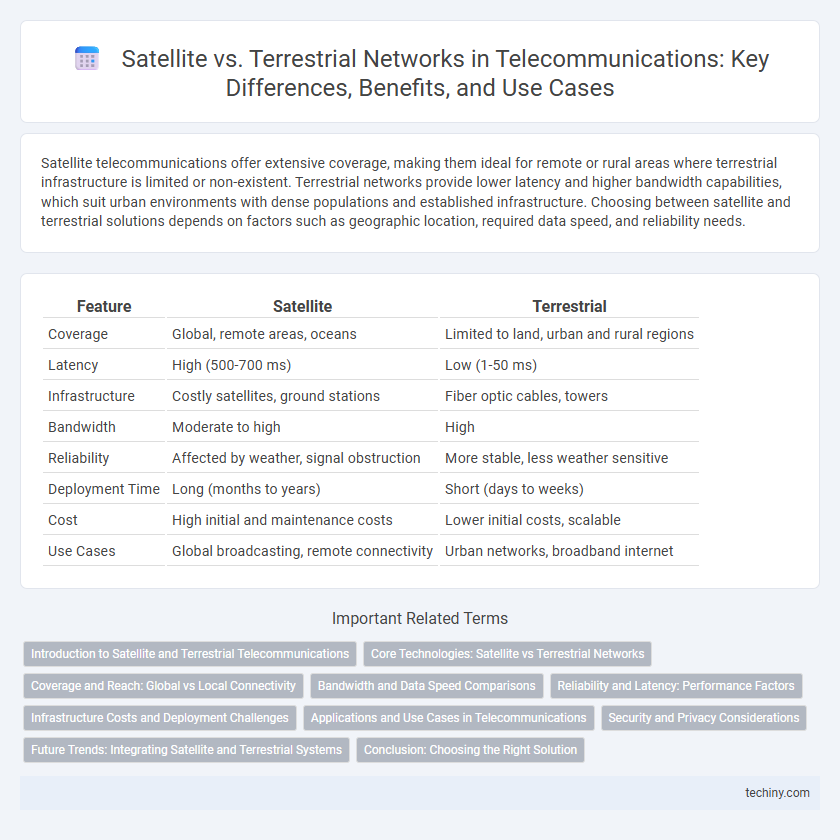Satellite telecommunications offer extensive coverage, making them ideal for remote or rural areas where terrestrial infrastructure is limited or non-existent. Terrestrial networks provide lower latency and higher bandwidth capabilities, which suit urban environments with dense populations and established infrastructure. Choosing between satellite and terrestrial solutions depends on factors such as geographic location, required data speed, and reliability needs.
Table of Comparison
| Feature | Satellite | Terrestrial |
|---|---|---|
| Coverage | Global, remote areas, oceans | Limited to land, urban and rural regions |
| Latency | High (500-700 ms) | Low (1-50 ms) |
| Infrastructure | Costly satellites, ground stations | Fiber optic cables, towers |
| Bandwidth | Moderate to high | High |
| Reliability | Affected by weather, signal obstruction | More stable, less weather sensitive |
| Deployment Time | Long (months to years) | Short (days to weeks) |
| Cost | High initial and maintenance costs | Lower initial costs, scalable |
| Use Cases | Global broadcasting, remote connectivity | Urban networks, broadband internet |
Introduction to Satellite and Terrestrial Telecommunications
Satellite telecommunications utilize orbiting satellites to transmit signals over vast geographical areas, enabling global coverage and connectivity in remote or underserved regions. Terrestrial telecommunications rely on ground-based infrastructure such as fiber optics, microwave towers, and cellular networks to provide high-speed, low-latency communication primarily within localized or urban environments. Both systems complement each other by addressing different coverage needs, bandwidth capacities, and latency requirements in modern communication networks.
Core Technologies: Satellite vs Terrestrial Networks
Satellite networks rely on geostationary or low Earth orbit satellites to deliver wide-area coverage and support long-distance communication, utilizing microwave and radio frequency technologies for signal transmission. Terrestrial networks, on the other hand, employ fiber-optic cables, cellular towers, and microwave links to provide high-capacity, low-latency connectivity primarily for urban and regional coverage. Core technologies in terrestrial systems focus on dense infrastructure and advanced modulation techniques, while satellite networks emphasize signal propagation, orbital dynamics, and antenna design to overcome latency and bandwidth challenges.
Coverage and Reach: Global vs Local Connectivity
Satellite communications provide extensive global coverage, enabling connectivity in remote and underserved regions where terrestrial networks face infrastructure limitations. Terrestrial networks offer high-capacity, low-latency connections optimized for local and urban areas with dense population and infrastructure. Combining satellite and terrestrial technologies enhances overall network reach, ensuring seamless connectivity from global to local scales in telecommunications.
Bandwidth and Data Speed Comparisons
Satellite communications generally offer lower bandwidth and slower data speeds compared to terrestrial networks due to signal latency and atmospheric interference. Terrestrial networks, particularly fiber-optic systems, provide higher bandwidth capacities and faster data transmission rates, supporting advanced applications like 5G and high-definition streaming. Satellite technology excels in coverage over remote areas, but limited spectrum availability restricts its ability to match the speed and bandwidth efficiency of terrestrial infrastructure.
Reliability and Latency: Performance Factors
Satellite communication often experiences higher latency due to the long signal travel distance to and from orbiting satellites, typically around 500 to 700 milliseconds. Terrestrial networks, utilizing fiber optics and microwave transmissions, provide lower latency, generally under 50 milliseconds, resulting in more reliable real-time data transfer and voice communications. Reliability in terrestrial systems benefits from redundant infrastructure and easier maintenance, whereas satellite systems face challenges from weather interference and limited bandwidth.
Infrastructure Costs and Deployment Challenges
Satellite communication infrastructure requires significant upfront investment in satellite manufacturing, launch, and ground station equipment, often leading to higher initial costs compared to terrestrial networks, which depend heavily on extensive physical infrastructure like fiber-optic cables, towers, and base stations. Deployment challenges for satellite systems include latency issues, limited bandwidth capacity, and complex regulatory approvals, whereas terrestrial networks face difficulties with site acquisition, geographic obstacles, and maintenance in urban or remote areas. Cost efficiency in terrestrial systems improves with population density, while satellite networks offer broader coverage in underserved or hard-to-reach regions despite higher operational expenses.
Applications and Use Cases in Telecommunications
Satellite communication excels in providing coverage to remote and underserved areas, supporting applications like global broadcasting, maritime connectivity, and disaster recovery where terrestrial infrastructure is limited or non-existent. Terrestrial networks, including fiber optics and cellular towers, dominate urban and densely populated regions, enabling high-capacity, low-latency services such as 5G mobile broadband and enterprise connectivity. Hybrid solutions leveraging both satellite and terrestrial systems optimize network resilience and coverage, facilitating seamless communication across diverse geographic and operational scenarios.
Security and Privacy Considerations
Satellite communications face unique security challenges due to signal interception risks from broad coverage footprints, necessitating robust encryption protocols and anti-jamming technologies. Terrestrial networks benefit from more localized transmission paths, enabling tighter physical security controls and easier implementation of network segmentation to protect privacy. Both systems require advanced cybersecurity measures to safeguard data integrity and prevent unauthorized access in an evolving threat landscape.
Future Trends: Integrating Satellite and Terrestrial Systems
Future trends in telecommunications emphasize the integration of satellite and terrestrial systems to enhance network resilience and coverage, particularly in remote and underserved areas. Advances in low Earth orbit (LEO) satellite constellations and 5G infrastructure enable seamless handoff and hybrid connectivity, driving improvements in latency, bandwidth, and reliability. This convergence supports emerging applications such as IoT, autonomous vehicles, and smart cities by providing ubiquitous, high-speed communication across diverse environments.
Conclusion: Choosing the Right Solution
Selecting between satellite and terrestrial telecommunications depends on factors such as coverage, infrastructure costs, latency, and bandwidth requirements. Satellite systems offer extensive global reach and rapid deployment in remote areas, while terrestrial networks provide lower latency and higher reliability in urban environments. Evaluating specific use cases and geographic constraints ensures optimal connectivity and cost-efficiency.
Satellite vs Terrestrial Infographic

 techiny.com
techiny.com